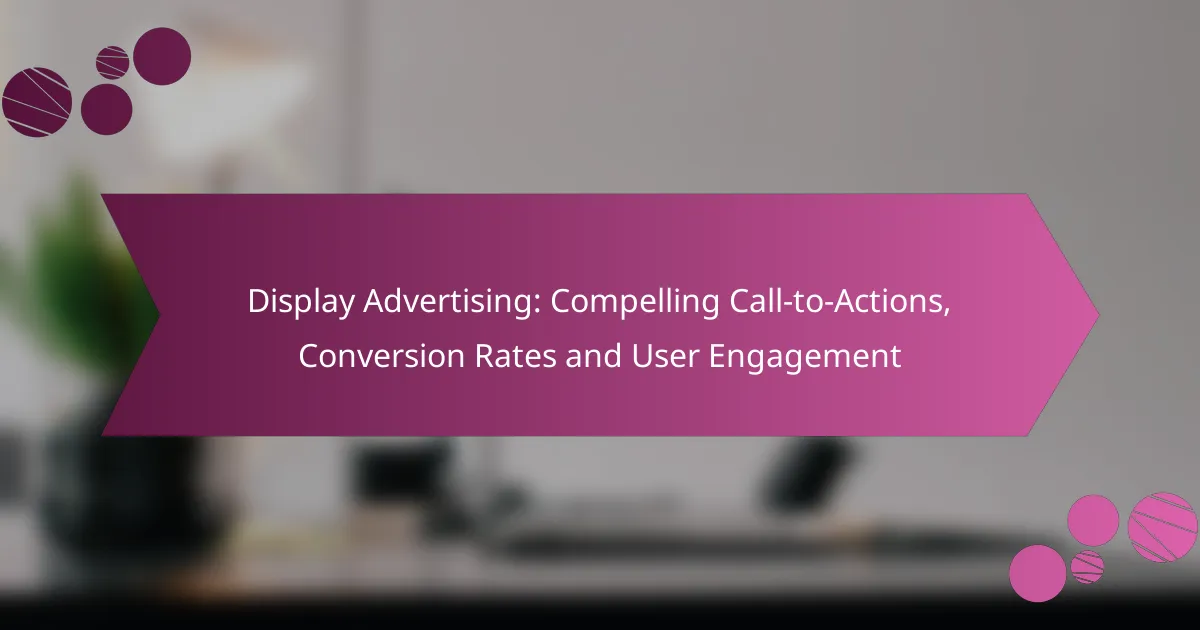Display advertising relies heavily on compelling call-to-actions (CTAs) to drive user engagement and conversion rates. By prompting users to take specific actions, effective CTAs can significantly enhance the performance of ads, leading to improved business outcomes. The choice of ad format also plays a crucial role, with video and interactive ads often yielding higher engagement compared to traditional formats.

How can compelling call-to-actions improve display advertising?
Compelling call-to-actions (CTAs) significantly enhance display advertising by prompting users to take specific actions, such as clicking on an ad or making a purchase. Effective CTAs can lead to increased interaction and ultimately drive better business outcomes.
Increased click-through rates
Compelling CTAs can lead to higher click-through rates (CTR) by clearly communicating the value of clicking on an ad. Phrases like “Get Started Now” or “Limited Time Offer” create a sense of urgency that encourages users to engage. Testing different wording and designs can help identify the most effective options.
Consider using contrasting colors for your CTA buttons to make them stand out. A well-placed CTA can increase CTR by significant margins, often in the range of 20-50% compared to less engaging alternatives.
Enhanced user engagement
Effective CTAs not only drive clicks but also foster deeper user engagement with the content. Engaging CTAs can lead users to explore more of your website or app, increasing the time they spend interacting with your brand. For example, a CTA that invites users to “Discover More” can lead to additional page views and a richer user experience.
To enhance engagement, tailor your CTAs to specific audience segments. Personalization can lead to better alignment with user interests, making them more likely to interact with your content.
Higher conversion rates
Compelling CTAs can significantly boost conversion rates by guiding users toward desired actions, such as signing up for a newsletter or completing a purchase. Clear and direct CTAs, like “Buy Now” or “Sign Up Free,” can reduce confusion and streamline the decision-making process for users.
To maximize conversions, ensure that your CTAs are relevant to the surrounding content and provide a clear benefit. A/B testing different CTAs can help determine which ones resonate best with your audience, often resulting in conversion rate increases of 10-30% when optimized effectively.

What are effective call-to-action examples for display ads?
Effective call-to-action (CTA) examples for display ads include clear and compelling phrases that encourage users to take immediate action. These CTAs should be concise, visually appealing, and relevant to the ad’s content to maximize engagement and conversion rates.
Shop Now buttons
“Shop Now” buttons are direct and create a sense of urgency, prompting users to make a purchase immediately. They work best when paired with enticing visuals and limited-time offers, making the decision to buy feel more pressing.
To enhance effectiveness, ensure the button stands out with contrasting colors and is placed prominently within the ad. Testing different placements and designs can help identify what resonates best with your audience.
Sign Up for Free Trials
“Sign Up for Free Trials” CTAs invite users to experience a product or service without any financial commitment. This approach is particularly effective for software and subscription services, as it lowers the barrier to entry and allows potential customers to evaluate the offering firsthand.
When using this CTA, highlight the benefits of the trial and any unique features that set your product apart. Consider adding a countdown timer to create urgency and encourage quicker sign-ups.
Learn More prompts
“Learn More” prompts are ideal for ads that introduce new products or services, encouraging users to seek additional information before making a decision. This CTA works well in educational or informative contexts where users may need more details to feel confident in their choice.
To maximize engagement, link the prompt to a dedicated landing page that provides comprehensive information, testimonials, or case studies. Ensure that the landing page is user-friendly and optimized for conversions to facilitate the next steps in the customer journey.

How do conversion rates vary by display ad format?
Conversion rates for display ads can differ significantly based on the ad format used. Generally, video ads tend to have higher engagement and conversion rates compared to traditional banner ads, while interactive ads can further enhance user interaction and response.
Banner ads performance
Banner ads are one of the most common forms of display advertising, typically featuring static or animated images. Their conversion rates usually range from low single digits to low teens in percentage terms, depending on placement and design. To improve performance, ensure that banners are visually appealing and include a clear call-to-action.
Consider A/B testing different designs and messages to identify what resonates best with your audience. Avoid cluttered designs, as they can detract from the main message and reduce click-through rates.
Video ads effectiveness
Video ads are increasingly popular due to their ability to capture attention and convey messages effectively. They often achieve higher conversion rates, sometimes reaching the mid-teens to low twenties in percentage terms. The key to success with video ads is to keep them concise and engaging, ideally under 30 seconds.
Utilizing platforms like YouTube or social media can enhance visibility. Ensure that the video includes a strong call-to-action at the end to prompt viewers to take the next step.
Interactive ads engagement
Interactive ads encourage user participation, which can lead to higher engagement and conversion rates. These ads often include elements like quizzes, polls, or games, resulting in conversion rates that can exceed those of standard formats. The interactive nature keeps users engaged longer and increases the likelihood of conversion.
When designing interactive ads, focus on user experience and ensure that interactions are intuitive. Avoid overly complex mechanics that may frustrate users, and always provide a clear path to conversion, such as a sign-up or purchase option.

What factors influence user engagement in display advertising?
User engagement in display advertising is influenced by several key factors, including ad placement, audience targeting, and visual design. Each element plays a crucial role in capturing attention and encouraging interaction, ultimately affecting conversion rates.
Ad placement strategies
Effective ad placement strategies are essential for maximizing visibility and engagement. Ads should be positioned in high-traffic areas of a webpage, such as above the fold or near relevant content. Testing different placements can help identify which locations yield the best results.
Consider using a mix of placements, including banner ads, sidebars, and in-content ads. Each format has its advantages, so experimenting with combinations can lead to improved user engagement.
Target audience segmentation
Segmenting your target audience allows for more personalized and relevant advertising. By analyzing demographics, interests, and online behavior, you can tailor ads to specific groups, increasing the likelihood of engagement. Tools like Google Analytics can assist in gathering this data.
Utilize techniques such as retargeting to reach users who have previously interacted with your brand. This approach often results in higher conversion rates, as these individuals are already familiar with your offerings.
Visual design elements
Visual design elements significantly impact user engagement in display advertising. High-quality images, bold colors, and clear typography can attract attention and convey your message effectively. Ensure that your design aligns with your brand identity for consistency.
Incorporate strong call-to-action buttons that stand out and encourage users to click. Use contrasting colors and concise text to make these elements pop. A/B testing different designs can help determine which visuals resonate best with your audience.

What metrics should be tracked for display advertising success?
To measure display advertising success, focus on key metrics such as click-through rate (CTR), conversion rates, and return on ad spend (ROAS). These metrics provide insights into user engagement and the effectiveness of your advertising campaigns.
Click-through rate (CTR)
Click-through rate (CTR) indicates the percentage of users who click on your ad after viewing it. A higher CTR suggests that your ad is engaging and relevant to your target audience. Aim for a CTR of around 0.5% to 2% as a general benchmark, but this can vary by industry.
To improve CTR, use compelling visuals and clear messaging in your ads. A/B testing different ad formats and placements can help identify what resonates best with your audience. Avoid overly complex designs that may distract from the call-to-action.
Conversion rate analysis
Conversion rate analysis measures the percentage of users who complete a desired action after clicking on your ad, such as making a purchase or signing up for a newsletter. A good conversion rate typically ranges from 1% to 5%, depending on the industry and campaign goals.
To enhance conversion rates, ensure that the landing page aligns with the ad’s promise and provides a seamless user experience. Utilize clear calls-to-action and minimize distractions on the landing page. Regularly analyze user behavior to identify and address any barriers to conversion.
Return on ad spend (ROAS)
Return on ad spend (ROAS) calculates the revenue generated for every dollar spent on advertising. A ROAS of 4:1 is often considered a good target, meaning you earn four dollars for every dollar spent. However, this can vary based on your business model and goals.
To optimize ROAS, focus on targeting the right audience and refining your ad spend across channels. Regularly review campaign performance and adjust budgets to allocate more funds to high-performing ads. Avoid overspending on underperforming campaigns to maintain a healthy return.








